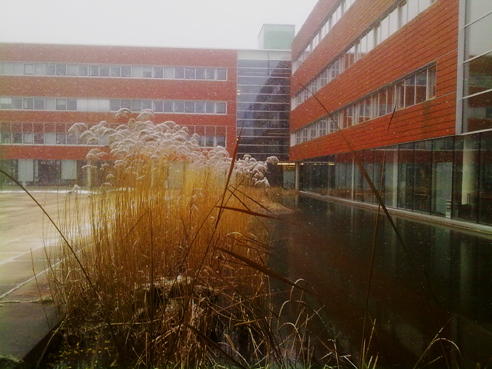German Society for Cell
Biology International Meeting Report
By Peter Walentek
Peter Walentek is a postdoctoral fellow in
Richard Harland's lab at the
University of California, Berkeley. He won the best postdoctoral
presentation at the
Hilde Mangold Postdoctoral
Symposium at the Society for Developmental Biology 74th
Annual Meeting in Snowbird, Utah. His prize
was a travel award to the meeting or course of his
choice. Below is his report.
In March 2016 the annual
International Meeting of
the German Society for Cell Biology (DGZ) was held
in Martinsried. The meeting took place at the new
biomedical campus of
Ludwig-Maximilians-University (LMU)
just outside of Munich. This new home for most of
LMU’s biological research groups is situated in
close proximity to the University Hospital center
Grosshadern as well as the Max-Planck-Institute for
Biochemistry in Martinsried. Thus, the new campus is
not only exciting because of its modern
architecture, but also due to its location at the
center of one of the main hubs for biomedical
research in Germany.
Although I see myself mainly as a developmental
biologist, I decided to use the generous Hilde
Mangold award from the SDB to attend this meeting
because my research on the formation and function of mucociliary epithelia is quite multidisciplinary and
involves a lot of cell biology. I am using the
Xenopus embryonic epidermis (which develops multiciliated and secretory cells) as a model for
airway epithelia, and I am interested in the
signaling and gene-regulatory networks that regulate
development and regeneration of these epithelia. In
order to understand the effects of manipulations on
the epithelium as a whole, one must also understand
the changes at the cellular level, e.g., how defects
in morphogenesis of a specific cell type affect the
function of the epithelium, and which translational
consequences that might have in the context of
chronic airway disease.
|
 |
|
Biomedical Research Centre at
Ludwig-Maximilians University |
The meeting offered plenty of opportunity to dive
into various topics on cell biology, including
nuclear architecture, the role of the cytoskeleton
in mechanosensing, and membrane trafficking, covered
during plenary sessions; as well as topics ranging
from RNA biology, to cell migration and adhesion, to
the role of stem cells in regeneration, during
concurrent sessions. One especially exciting plenary
session focused on the relationship between nuclear
architecture and gene regulation.
Sandra Hake (LMU,
Martinsried) presented some recent findings on the
histone variant H2A.Z, which influences the
transcriptional output of E2F regulated genes in
human melanoma cells. Furthermore, experiments using
Xenopus embryos suggest additional roles of this histone variant in vertebrate development.
Michael Hannus (siTools, Martinsried) compared the RNAi and
CRISPR/Cas9 methods, which both have some issues
with off target effects that are hard to assess in
routine experiments. Their new approach is to
deliver a mix of siRNAs designed against a common
target. This allows use of each individual siRNA at
levels low enough to prevent off target effects, but
in combination the target gene is efficiently
depleted. This seems to be a clever use of the
technology, which might be adapted to the CRISPR/Cas9
system or morpholino oligonucleotides as well. As
the final speaker of the session,
Ana Pombo (Max-Delbrueck
Center for Molecular Medicine, Berlin) introduced a
new method for genome architecture mapping, which is
complementary to Hi-C studies and is being used to
investigate three-dimensional chromosome folding and
transcriptional regulation. Instead of fragmenting
and re-ligating DNA in the tube to reveal DNA
topology, this method uses DNA libraries from
cryosections of nuclei. Interacting regions of the
genome can be determined by analyzing libraries from
many single nuclei samples, in which they are over
represented in comparison to non-interacting
regions.
Further personal highlights of the meeting include a
talk by
Roland Wedlich-Söldner (Institute of Cell
Dynamics and Imaging, Muenster) on calcium-mediated
reorganization of the cortical actin network. Upon
mechanical stress, calcium is released and cortical
actin relocates to the nuclear and ER membranes.
This alters cell stiffness and behavior as well as
gene expression in the simulated cell and even in
neighboring cells. Another talk involving
cytoskeletal regulation—this time during cytokinesis—by
Esther Zanin (LMU, Munich) caught my attention.
Using C. elegans embryos, she showed how amounts and
localization of TPXL-1, which interacts with Aurora
A kinase, regulate spindle positioning by
influencing centrosomal microtubulin dynamics.
In addition to the great talks during plenary and
concurrent sessions, two excellent poster sessions
in the early afternoons offered opportunities to
discuss the latest research findings and preliminary
data from students and postdocs. In the late
afternoons and evenings several keynote and award
lectures were held, including a Carl Zeiss lecture
by
Thomas Pollard (Yale, New Haven) highlighting his
lab’s seminal work on cytokinesis, and a Frontiers
in Science lecture by
Peter Becker (LMU, Martinsried)
on the regulation of X chromosome dosage
compensation in Drosophila by the MSL dosage
compensation complex, and the roles of non-coding
RNAs and RNA binding proteins within this complex.
Taken together, this was a great meeting to get the
latest updates on the field of cell biology, which
also highlighted the many ways researchers use
embryonic model systems to address cell biological
questions. Therefore, I am very grateful that the
SDB allowed me to use the Hilde Mangold award to
participate in this meeting and to visit the new LMU
campus in Munich.
|